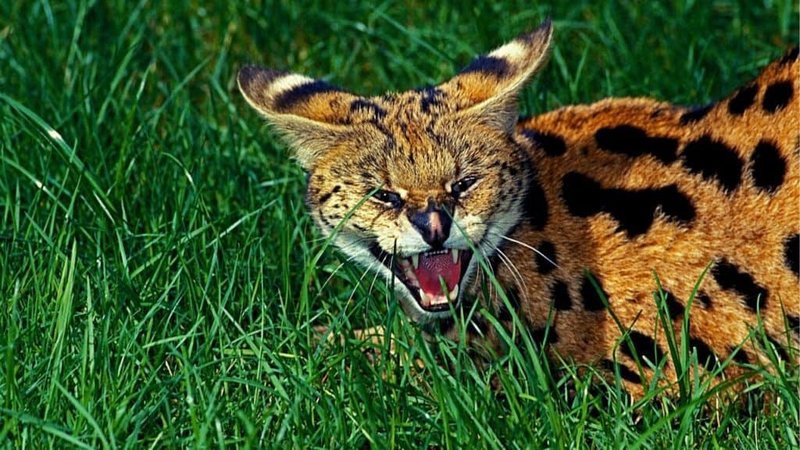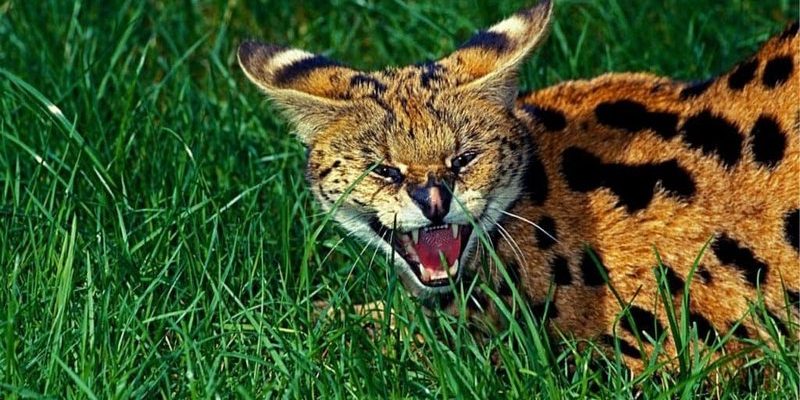
Imagine you’re sitting in a café, sipping your coffee, and someone mentions a serval. You might picture it lounging in the sun, its big ears perked up and its graceful body sleek and agile. But are these adorable felines a potential danger? Let me explain what you need to know about these enchanting creatures and their interactions with people.
What is a Serval?
To start things off, let’s break down what exactly a serval is. These wild cats, native to Africa, are known for their long legs, large ears, and striking spotted coat. They’re about the size of a medium domestic cat but have a more elongated body. Servals are expert hunters, using their keen hearing to locate prey and their powerful legs to leap into action—sometimes up to 10 feet in the air!
You might be surprised to learn that servals primarily hunt small mammals, birds, and insects. They often hunt at night, using their excellent eyesight to their advantage. Their natural habitats include savannas, grasslands, and wetlands, where they can blend into the tall grasses. So, while they’re captivating to watch, they’re also formidable predators in their own right.
Are Servals Naturally Aggressive?
Here’s the thing: servals aren’t typically aggressive toward humans. In fact, they tend to be shy and elusive, avoiding human contact whenever possible. When they feel threatened, their first instinct is usually to flee rather than fight. So, if you were to encounter a serval in the wild, it might sneak away before you even realized it was there.
However, like any wild animal, servals can display aggression if they feel cornered or threatened. This is especially true if they’re protecting their young or if they’re surprised. In rare cases, a serval may see a human as a threat and react accordingly. But overall, these cats aren’t out to hunt us down or cause harm.
The Myth of the Dangerous Serval
You might wonder if servals have gotten a bad rap in the media. It’s not uncommon for sensational stories to depict wild animals as dangerous to grab attention. While it’s true that servals have sharp claws and teeth—tools of their trade for hunting and defending themselves—they don’t actively seek out human prey. The idea of them being dangerous is often exaggerated.
Most reported incidents involving servals and humans stem from misunderstandings or provoked situations. People approaching a serval too closely, especially in the wild, might provoke a defensive reaction. In contrast, those who respect the animal’s space are unlikely to find themselves in a dangerous scenario.
Can Servals Be Domesticated?
Now, here’s a twist: some people do keep servals as exotic pets. You might be wondering, is this a good idea? While servals are beautiful and can be trained to some extent, they are still wild animals at heart. This means they can be unpredictable.
People who keep servals often find themselves grappling with behaviors typical of a wild cat, such as hunting instincts and territorial aggression. Though they can bond with humans, focusing on their needs and creating an appropriate environment is crucial.
Keeping a serval also comes with legal and ethical considerations. In many places, owning a serval requires specific permits, and it’s essential to research local laws before even thinking about having one as a pet.
Why Do People Fear Servals?
So, what stirs up fear around servals? Part of it might stem from how we view all wild cats. There’s a natural instinct to be cautious around animals that can potentially cause harm. The serval’s sharp physical features and agile hunting skills can evoke a sense of unease.
Additionally, stories of wild animals escaping captivity or causing harm can reinforce these fears. Society often portrays wild cats as fierce predators, leading to a fear of the unknown. However, educating ourselves about servals can help dispel myths and offer a more balanced view of these animals.
How to Stay Safe Around Servals
If you find yourself in an area where servals roam, there are simple ways to ensure safety. Here are some tips:
- Keep Your Distance: If you spot a serval in the wild, enjoy observing it from afar. Use binoculars for a better view without getting too close.
- Respect Their Space: Never approach a wild serval or attempt to feed it. This is crucial for your safety and the animal’s well-being.
- Educate Yourself: Understanding servals and their behavior can go a long way in reducing fear. The more you know, the more comfortable you’ll feel around them.
By being informed and aware, you can appreciate these beautiful creatures without unnecessary fear.
The Bottom Line
In the end, servals are not inherently dangerous to humans. While they possess the physical abilities to defend themselves, they usually prefer to avoid confrontation. The fascination with these wild cats often overshadows the reality of their nature. By respecting their space and understanding their behavior, we can peacefully coexist with servals and admire their beauty from a safe distance.
If you’re ever lucky enough to see one in the wild, remember to marvel at their grace, agility, and the important role they play in their ecosystem. They may be wild, but with a little understanding, you’ll see that there’s nothing to fear.

